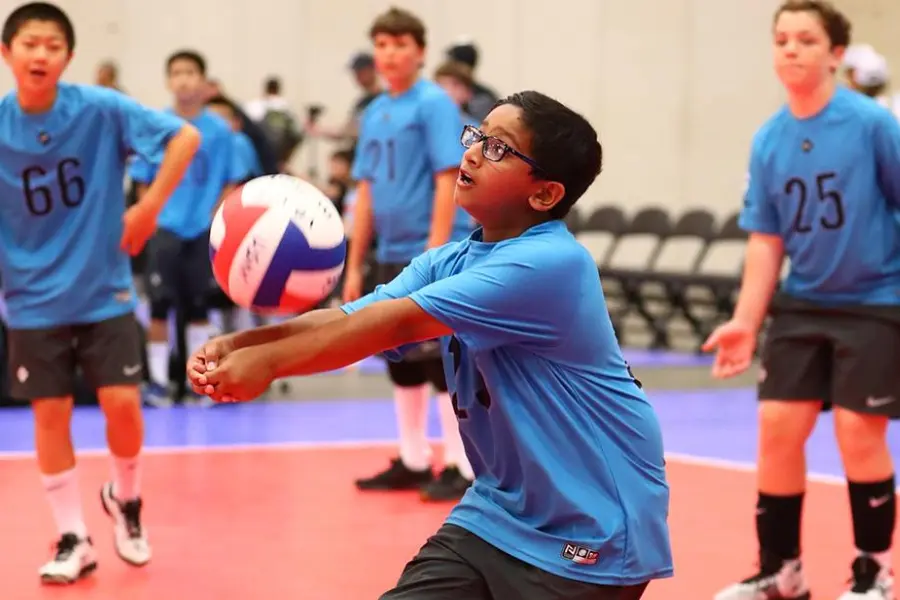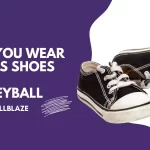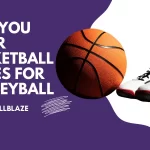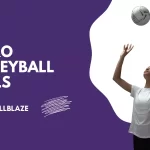The sport of volleyball is one of the most popular and exciting in the world. There is a lot of skill and strategy involved in this fast-paced and competitive game. Some aspects of volleyball are considered “out of bounds” even though many know the basic rules.
Disqualification or penalties can be imposed for these areas or actions during a game. Volleyball players and coaches need to know what is out of bounds in order to become effective competitors. This article discusses the various out of bounds rules in volleyball and how they can help you improve as a player.
A ball must pass over or between the sideline boundaries after reaching the net. In the absence of this, the game will continue on the other side of the net. It is possible for a ball to go out of bounds for a variety of reasons. Players who are out of bounds by the opposing team can take free throws if they score two points or fewer.
Locations and games with off-limits areas vary from one to another. During a match, if one side of the field is off-limits, the other will remain open. Hands and arms cannot be used to throw or bat a ball except under these rules.
Outside the boundary line, it is possible to play (hit) the ball. Balls that have been ruled out of bounds must be let fall to the ground; players cannot collect them and rule them out. As soon as the ball enters the net, it is called a short ball. It is classified by the coach as “deep” or “outer” once it crosses the sidelines. It is possible for opponents to play a ball when it lands in the vertical net plane.
Serving out of bounds or into the net will result in the server losing the point.
Players must take stroke-and-distance relief if a ball is lost or out of bounds by adding one penalty stroke and playing the original ball or another ball from the spot where the previous stroke was taken (see Rule 14.6).
In the event the player touches the floor or an object on or outside of a boundary, she is considered out of bounds. Players’ positions in the air are determined by how far they have reached the ground.
What Is In Bounds In Volleyball?

The area of the court inside the line of the court is known as the in-bounds area in volleyball. In this area, the game is played, and all players must remain within it at all times. Also included in the in-bounds zone are the ceiling and walls above the court. A player cannot touch the ball while it is outside the court, and the ball must remain on the court at all times.
Any area outside the court, such as sidelines and benches, falls within the in-bounds area. Instead of playing the game, players use this area to rest or switch positions during breaks.
On the other hand, the libero position is so crucial to volleyball that it should not be overlooked. Playing in the back row as well as covering a large area of court is the goal of liberos.
Taller players can reach more balls because the shortest players cover more ground in the back row. A team’s defensive prowess determines whether they win or lose, and is an important component of their success. In a variety of camps and leagues, you can learn the fundamentals and compete in a competitive environment.
You can also take part in coaching to learn the fundamentals of the position and become a great defensive specialist. If properly trained and practiced, the libero position can be a very rewarding experience.
You may enjoy reading Volleyball Centerline Violation
How Many Players Are There In One Volleyball Team?
Each match consists of two teams of six players, with two males and two females, or four men and four women.
What Is An Out Ball In Volleyball?

When a volleyball ball is hit out of bounds, or when a player, such as the setter, hits the ball out of bounds, it is known as an out ball. This results in a point being awarded to the team that was not responsible for the ball being out of bounds.
A ball that is hit too hard or with insufficient control will result in an out ball. Besides touching the ceiling or any other object above the court, out balls are also called. To play volleyball correctly, you must know when an out ball occurs.
All rallies are scored in Intramural volleyball matches, which are decided by the best two out of three games. If spectators, players, or coaches behave inappropriately, they may be ejected or forfeited. Knee braces that have 1/2 inch slow recovery rubber or similar materials and are hard, unyielding materials covering both sides and all edges are required.
The coin toss will determine whether there will be a third game. Whenever there are three games, there will be a two minute break for each team, with a six minute break if all three games are played. Ultimately, the team with the most points will win and take the lead by two points. Players are double hit when they illegally contact the ball twice in succession or when the ball bounces off their bodies.
Referees will initiate a replay when two players simultaneously hold the ball. The purpose of screening is to prevent the receiving players from seeing the server or the ball’s flight. The ball can be contacted by front line players anywhere on the court, including from the inside. It is prohibited for anyone to touch the ground with any part of their body other than their feet.
Both players can hit the ball for the second hit if they are in simultaneous contact. Whenever a server wishes to attempt serving, he must wait for the official to signal. You must either serve from the line or from inside the court in order to make a good serve.
Side outs are called when a ball lands out but does not touch the ground before being called. Serves that land inbounds and do not touch the net can be let serve. Sidelines, end lines, and centerlines cannot be closer to one player than another.
The ball becomes legally connected to the network when a legally binding agreement is reached with the service. Outside the court, it will die if it comes into contact with the antenna or any part of the network.
The game and players can be severely damaged by illegal head hits. If the rules are violated, a point or even a game can be lost depending on the severity of the hit. A player who holds, throws, slaps, bumps, carries, or directs the ball is considered to have made an illegal hit.
Moreover, players are not allowed to make consecutive contacts with the ball unless they first make contact with it. An illegal hit is similarly regarded as one that visibly lands. Legal play requires the ball to leave the player’s hand immediately after it strikes him.
In order to ensure fair play and player safety, these rules were implemented. If you violate the rules, you will face serious consequences. Using the right technique to hit the ball is critical to avoiding penalties and abiding by the rules.
Understanding Volleyball Out-of-bounds Rules
The term “out ball” refers to a ball that comes into contact with the antenna when it comes completely outside the boundary lines, or when it touches the wall or net surrounding it. Three hits are allowed before returning the ball, and a 2-inch line marks out-of-bounds.
Balls remain in bound even if they touch the line during play. When the receiving team does not touch the ball before it hits the ground, a side out is called. It is considered a let serve as long as it does not touch the net.
Volleyball players score points by serving or swinging the ball inbounds. As soon as the ball lands out of bounds, the opposing team scores a point. Additionally, if the ball hits the opponent’s antenna and the line, it is considered in.
You may enjoy reading Can You Touch the Net in Volleyball?
What If A Block Goes Out Of Bounds In Volleyball?

The ball is considered out of bounds if it hits the antenna before striking the ground, and the opposing team receives both the ball and a point.
The defense of a volleyball court depends heavily on it. Players on the front row must prevent the opposing team’s attackers from scoring a goal before the ball enters the net. Practicing proper footwork and technique can make block making much easier. According to the height and skill of their players, opposing teams use a variety of strategies.
As the ball passes by the net, the players reach their arms above the net to align themselves with the player. Moreover, they can perform a swing block by using their arms. Keeping an eye on the players on the other side of the net will help the blocker avoid getting caught in the middle.
The net cannot be approached by blockers. On the other side of the court, the ball must also be in the correct location. College and professional volleyball coaches can object to calls or points.
To determine whether the net has been touched, the referee must watch the play in slow motion. A block is when a player reaches over the net to block an attacker’s attack.
This is designed to prevent the ball from crossing the net or redirecting so that you can receive it more easily. Attack attempts from both sides of the opposing team can be blocked by front row players.
What Happens If You Hit The Ball Out Of Bounds In Volleyball?
When the ball crosses the net outside your antennas, return it to your side and if you have enough hits left, hit it across the net between your two antennas.
Can You Block Someone Out Of Bounds?
When a player attempts to block a player who is clearly out of bounds, the player is not clearly out of bounds. Blockers go out of bounds when they cross the sideline.
Is A Block Considered A Legal Hit In Volleyball?
Several rules were recently requested of me. Blocks or touches of the ball at the net are not considered team hits.After a block, the first hit is considered the first of three hits, regardless of whether it was delivered by the player who made the block or by anyone else.
You may enjoy reading Grass Volleyball Rules
Volleyball Hand Signal Out Of Bounds
Referees indicate out of bounds in volleyball by holding up their arms and waving them back and forth. In this signal, the ball is no longer in play after crossing a boundary line.
By using this hand signal, all players on the court are alerted that the ball is now out of bounds and must be returned to the center of the court before the next serve.
In addition to being used to allow players and spectators to know when the ball is out of bounds, it is also used to stop play when the ball is out of bounds.
Ball Lands In Bounds Volleyball Meaning

Professionals serve or swing at the ball; volleyballs land in bounds when they hit. In the event that it falls out of bounds, the other team will receive a point. As soon as it touches the opponent’s line, it’s in. Antennas lose power if they are struck.
You may enjoy reading How to Play Beach Volleyball?
Side Out In Volleyball
In volleyball, side out refers to regaining the right to serve after winning a point. In order to do this, the team that won the point must win the rally and have the ball land in bounds on the other team’s side of the court.
The team that served previously loses its serve when a side out is achieved, while the team that achieved the side out gains it. In volleyball, side out is important to maintain the flow of the game and to keep the score even.
Volleyball Rules
Volleyball rules ensure that all players can participate safely and fairly. There is a net in the middle of the court that divides the court into two halves. Three players are on each side of the net for each team. In this game, the ball is served over the net, and players must hit it over the net with their hands or arms. Balls that land outside the court or are not returned by the other team earn points.
Winners are determined by winning the best of three sets. It is also forbidden to block or attack the ball while it is in play according to the rules. Rotations and positions must also be followed to ensure everyone is active and participating on the court.
Rock/Paper/Scissors determines the serve, and Court/Scissors determines the court. The two thirty-second timeouts allowed per match are for each team. There is a two-point margin of victory (less than a scoring limit) if there is a deciding game.
Balls served via a net are considered in play if they do not continue over the net or do not land outside the opposing team’s court-side. It is possible to play the ball for three hits if it does not come in contact with the net. Balls that are touched by two players at the same time are dead and are replayed.
It is possible for a team to be fined one point or lose serve if it intentionally delays the game. When on or near the court, players, coaches, and/or team members should maintain a professional demeanor.
To attend the game, it is recommended that teams arrive 15 minutes prior to kickoff. Unsporting behavior includes disrespecting the referee, being disconcerted, attempting to influence his or her decision, and using foul language.
Teams that receive three yellow cards, two yellow cards, and one red card, as well as two red cards, will be disqualified. (Measured in co-rec), the net height is expected to be 7-foot-8. In rock, paper, scissors, the team with the serve or the court receives the serve or court.
After twenty-one points, one team wins if the score is tied at two points. The only team that wins two games in a row in a match is that team. Teams are permitted to take only two one-minute timeouts in a game.
Balls can be hit at the net (or any other method) legally. Serves cannot be blocked or spiked by the receiving team. Diamonds and boxes are the two permitted formations in sand volleyball.
If the ball rebounded immediately and did not lay against your body, it is legal to contact the ball with any part of your body above the waist.
A team with four players, including those on the same team, is permitted to tip, as is a team with three players. The game will be called off if the team intentionally delays it. It is defined as a double hit when a ball touches the body more than once in a row.
During the meal, the person in charge of serving will rotate into the serving position, and substitutions will take place continuously. It will remain in effect until the actions have been fully explained and confirmed.
There is a possibility that you will be permanently suspended after that. Referees and other officials must also be protected from abuse by players and teams. If spectators threaten or physically abuse officials, any team associated with them will be suspended indefinitely.
Coaches and players have responded enthusiastically to the announcement that volleyball rules will change starting in 2022. In 2022, the Libero will become the team’s captain for the first time, as the player is always substituted, a change that had not previously been possible. Due to the possibility of substituting regular players, this argument has been discounted.
Because liberos are usually the most experienced and skilled players on the team, and captains lead both on and off the court, this is an important development in the evolution of the game.
This new rule will result in stricter regulations for violations such as stepping over the line while serving, failing to serve the ball over the net correctly, hitting the ball illegally, and touching the net with any part of your body while it’s in play. Players will sustain fewer injuries thanks to the stricter regulations, as well as fair and consistent competition.
By implementing the new rules in 2022, more players will be able to lead by example and ensure that all players are treated fairly and safely. In the future, volleyball will be able to compete on an even playing field that is both safe and competitive.
You may enjoy reading Volleyball Serving Rules
Conclusion
As a volleyball player, you must adhere to out of bounds rules to ensure the integrity and fairness of the game. Ensure enjoyable and competitive matches by understanding and adhering to these regulations.





